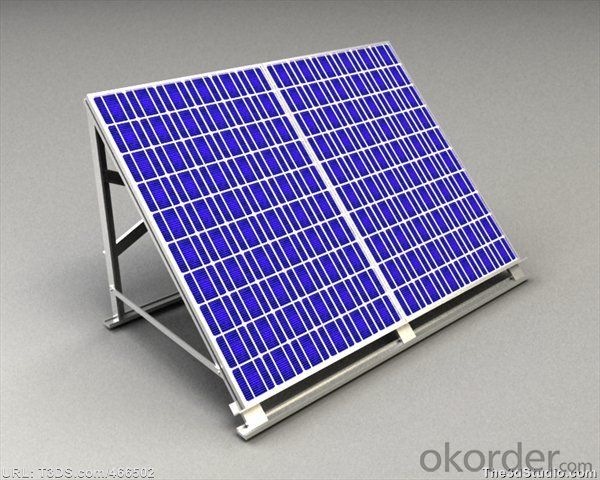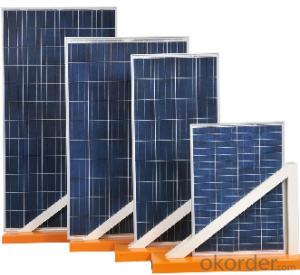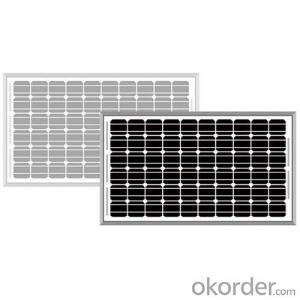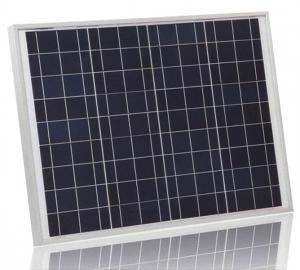Solar Panels Ni - Sale Monocrystalline Solar Panel 300W 36V
- Loading Port:
- China main port
- Payment Terms:
- TT or LC
- Min Order Qty:
- 1 pc
- Supply Capability:
- 10000000 pc/month
OKorder Service Pledge
OKorder Financial Service
You Might Also Like
1.Structure of Solar Module Description
CNBM Solar's photovoltaic module is designed for designed for large electrical power requirement. It is the optimal choice for both on-grid and off-grid power systems. CNBM Solar offers high performance of power per square foot of solar array.
2.Main Features of the Solar Module
Solar Cell: High efficency crystalline solar cell. Even if under the weak light, the solar module can produce maximum power output.
Tempered glass: Anti-reflecting coating and high transmission rate glass increase the power output and mechanical strength of solar module.
EVA and TPT: Using high quality EVA and TPT to prevent destroying and water.
Strong aluminum frames to strengthen the load hold and to stand against high wind.
Junction box: Multi function junction box with water proof.
Long lifetime: ≥25 years; Less power decrease.
Good performance of preventing from atrocious weather such as wind and hails.
Resisting moisture and etching effectively, not effected by geology.
The certificate issued by international authority: UL, TUV, IEC, VDE, CE.
Quick Details
| Place of Origin: | Guangdong China (Mainland) | Brand Name: | OCCREN | Model Number: | OCR-M |
| Material: | Polycrystalline Silicon | Size: | 1930*980*46 | Number of Cells: | 72 |
| Max. Power: | 300W | Warranty: | 25 years | Transform efficiency: | 17%~19% |
| Frame: | Anodized Aluminum Alloy | FF%: | >73.3% | Life Span: | 25years |
| Temperature Range: | -40°C~+80°C | Junction Box Type: | PPO, Black | length of cable(mm): | 900 |
| Working voltage(V): | 9~36V | Cell efficiency: | Above 17% |
Packaging & Delivery
| Packaging Detail: | With foam sheets laying inside and excellent carton packing outside or wood packing |
| Delivery Detail: | 10~15 days after deposit |
3.Solar Module Images
4.Solar Module Specification
280W 290W 300W Poly Solar Panel with good price
1.Quality A
2.Offer OEM service
3.Efficiency is above 17%
4.CE certificate
280W 290W 300W Poly Solar Panel with good price
280w poly solar panel
290w poly solar panel
300w poly solar panel
Solar panel advantages
1.High quality guarantee using high conversion efficiency crystalline silicon solar cells.
2.High performance bypass diodes minimize the power drop caused by shade.
3.High transmittance, low iron tempered glass; high performance EVA, a weatherproof back sheet and sandblast electrophoresis aluminum frame extend the application of modules greatly.
4.Sealed. Waterproof. Multi-functional junction box gives high level of safety.
5.Durable Glass Surface. Our glass surface has been proven to withstand falling hard steel marbles that weigh over 1kg.It can also support over 350KGS of load per square meter
5.FAQ of Solar Module
1. Q: Do you have your own factory?
A: Yes, we have. Our factory located in Jiangyin city, jiangsu province.
2. Q: How can I visit your factory?
A: Before you take off from your country, please let us know. We will show you the way,or arrange time to pick you up if possible.
3. Q: Do you provide free sample?
A: Usually we do not offer free sample
4. Q: Could you print our company LOGO on the nameplate and package?
A: Yes, we can do that.
- Q: is this fact true? - its a limitation to solar panels during summer when it's in extremly hot countrie. I've heard it from my science teacher .. please give detail if you have any and any more benefits/limitations is welcomed .. Thank you :) !
- Solar okorder /... you'll notice that they have different curves for different temperatures. But they do still produce power, certainly. I have an array on my roof, and it still manages to max out the inverter on a hot summer day. But I do notice that the top row, which is hotter due to heat rising from those below, consistently puts out a few less watts than the bottom row. So more sun is certainly better; direct light is exactly what's needed. But hot panels due to poor air circulation or high ambient temperature does cut into efficiency. (Solar thermal, of course, is a different story)
- Q: Can solar panels be installed on sloped roofs?
- Yes, solar panels can be installed on sloped roofs. In fact, sloped roofs are one of the most common types of roofs where solar panels are installed. The angle of the roof can be adjusted to optimize the positioning of the solar panels and increase their efficiency.
- Q: Do solar panels float?
- They'll float if you tie enough hundred dollar bills to them.
- Q: can this amount of solar charge these batteries.
- you need to have a voltage regulator on the gadget. That suggested, i imagine you're literally not giving it sufficient time. The battery might want to convey the voltage all the way down to its element. it is merely you attempt to replenish a huge reservoir with an eye fixed dropper. Bringing the voltage down would not help both. That lowers your ability.
- Q: i have this usb solar panel charger i am building and the solar panel is about 2by .5quot;, so i was wondering if a led light can power it, if so will one be good or would i need more? if so how many?
- While I understand Search's answer, because it was also my first reaction, am I wrong in thinking that this is some sort of science fair project, for which you need to power a solar panel indoors as though it were being illuminated by the Sun? The question at least makes sense in that context. Solar panels provide modest power even from room lighting, sometimes calculators are powered by small panels, but that is a tiny amount of current. . You'll probably do better by asking this question (a bit more clearly) over in Engineering. It's not really an Astronomy Space question, though there may be some crossover between the two groups of users. Meanwhile, while some white LEDs can be pretty dazzling to the eye, I don't know how much actual power they are pulling down compared to what you'll need the panel to generate, but I don't see why it shouldn't work. I just don't know how many LEDs you would need. . .
- Q: Are there any government incentives or rebates for installing solar panels?
- Yes, there are various government incentives and rebates available for installing solar panels. These incentives can include federal tax credits, state and local grants, and utility rebates. These programs aim to encourage the adoption of renewable energy sources and can significantly offset the upfront costs of installing solar panels. It is advisable to check with local authorities and utilities to determine the specific incentives and rebates available in a particular area.
- Q: (For a project)I know they are made of silicon, but I want to EVERYTHING they are made of. Ex Metal (What kind)Please tell me everything used from their production to the finished projectThank you
- photograph voltaic panels take power (and in all probability some oil for the plastic) to fabricate, yet that power, and the carbon footprint, is paid for many circumstances over in widespread operation, via the electrical powered energy that the panel generates. The life of the middle photograph voltaic cells is long (there are nonetheless some panels from the 970's that are nonetheless out and dealing), and contemporary panels are oftentimes warranted for 25 years, showing that even the manufacturers have self assurance in thier lifespan. yet whilst it ultimately comes time to eliminate the panels, the aluminum physique is as particularly recycled as the different aluminum, and the tempered, low-iron glass could properly be recycled, too. The plastic substrate is unavoidably solid - it has to stand up to the solar for some years. i do no longer understand what could desire to be achieved with that. The cells themselves are a intense grade of silicon, which has fee on the scrap industry. some panels are no longer made up of silicon - yet lots of the factors could desire to be recycled in a similar fashion. i'm no longer attentive to any intense panels being dumped or discarded at present. they're worth lots, even broken, that some hobbyist or surplus place will purchase them.
- Q: Can solar panels be used for irrigation systems?
- Yes, solar panels can be used to power irrigation systems. Solar energy can be harnessed by the panels and converted into electricity, which can then be used to run pumps and other components of an irrigation system. This renewable energy source offers a sustainable and cost-effective solution for powering irrigation systems, especially in remote or off-grid areas.
- Q: Can solar panels be used to charge electric vehicles?
- Yes, solar panels can be used to charge electric vehicles. By installing solar panels on rooftops or in parking lots, the energy generated from the sun can be used to charge the batteries of electric vehicles, providing a clean and sustainable source of power. This helps reduce reliance on fossil fuels and promotes renewable energy use in transportation.
Send your message to us
Solar Panels Ni - Sale Monocrystalline Solar Panel 300W 36V
- Loading Port:
- China main port
- Payment Terms:
- TT or LC
- Min Order Qty:
- 1 pc
- Supply Capability:
- 10000000 pc/month
OKorder Service Pledge
OKorder Financial Service
Similar products
Hot products
Hot Searches
Related keywords

































